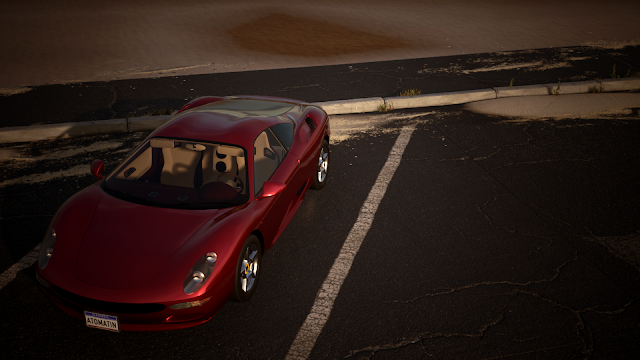Confessions of an Automationeer, Part 211: A Two-Door Bruiser for Keen Drivers
With the four-door HPG HL6 already completed, I began wondering if a high-performance two-door coupe version would be even better still - and so it was. To make that a reality, however, I had to make a lot of mechanical changes - aesthetic differentiation wouldn't be enough. So I chose to take the resulting build slightly further upmarket, into the more prestigious grand touring segment.
The first step was to give it a sleeker two-door bodyshell, using the same body set and wheelbase, but in notchback (rather than fastback) coupe configuration. That alone was insufficient to give the desired proportions, however, so I angled the windshield rake as far back as possible. Enlarging the wheel diameter by 17 inches also helped. The result was an even more athletic stance, one that was more obvious inside and out than in the donor car.
To back up the racier styling, I gave the mechanicals a once-over, and decided that it needed at least 40 more horsepower to be competitive - but I exceeded that target by 5 horsepower. Combined with 10 lb-ft of extra torque, it was enough to take it into sports car territory... in a straight line. But even with a 6-speed manual gearbox (with different ratios) and helical limited-slip differential to harness the extra power, it was clear that getting all that power to the ground safely needed a lot more work.
Keeping all of this in mind, I retained the lower ride height of the Sport package, but went one step further with stiffer spring/damper rates. However, I didn't go too far and compromise ride comfort in the process. In addition to this, uprated brakes helped cut fade to zero, while lower-profile high-performance tires and a functional aero kit yielded substantial improvements in grip - a necessity for something with more overt sporting intentions.
As for interior aesthetics, I only needed to make minor modifications, such as rescaling and moving some fixtures (a few of which were replaced by different variants within the same set). The deep purple interior accents remained, but the background interior color was mainly tan or cream instead of gray. In addition, most of the chrome-finished exterior brightwork was replaced with plastic trim. Finally, I fitted a pair of tailpipes on each side at the rear instead of the single items I used previously.
Above, from top: The HPG HL6 was already attractive enough to stand out from the crowd in its original four-door form - and this is even more true of the two-door version, especially in Sport trim.
Regarding standard equipment, very few changes had to be made, except for having adjustable adaptive dampers by default. This trades a small amount of reliability for extra sportiness and comfort - a boon in the GT market the HL6 Coupe would've competed in.
Above, from top: The interior of the HPG HL6 Coupe is marginally less practical, with one fewer seat, but has a more intimate feel - and perhaps fittingly, a sportier one in the Sport trim level.
In short, the HPG HL6 Coupe delivers a surprising amount of grace and pace for a large two-door coupe, without sacrificing too much space. To be fair, however, it wasn't my first attempt at making a grand tourer or personal luxury coupe in Automation using any of the two largest sizes of the '89 Ice Cream body set, but after looking back on it, I can proudly say that it was the best by far. The Discourse post showcasing this car can be found here if you want to find out more about it.


















